1995 HONDA ODYSSEY door lock
[x] Cancel search: door lockPage 4 of 240
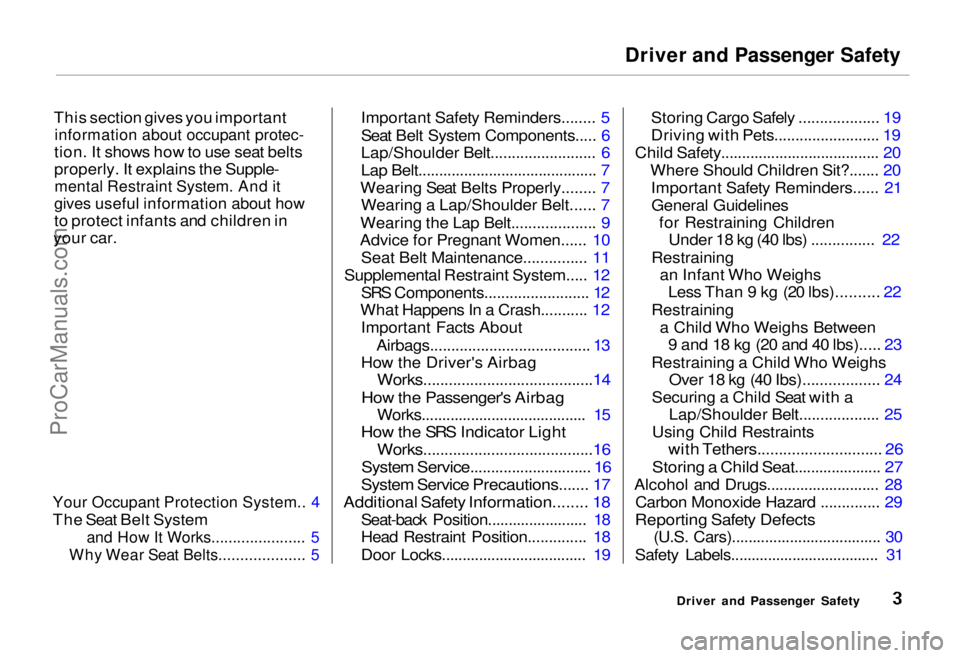
Driver and Passenger Safety
This section gives you important
information about occupant protec-
tion. It shows how to use seat belts
properly. It explains the Supple-
mental Restraint System. And it
gives useful information about how
to protect infants and children in
your car.
Your Occupant Protection System.. 4
The Seat Belt System
and How It Works...................... 5
Why Wear Seat Belts.................... 5
Important Safety Reminders........ 5
Seat Belt System Components..... 6
Lap/Shoulder Belt......................... 6
Lap Belt........................................... 7
Wearing Seat Belts Properly........ 7 Wearing a Lap/Shoulder Belt...... 7
Wearing the Lap Belt.................... 9
Advice for Pregnant Women...... 10
Seat Belt Maintenance............... 11
Supplemental Restraint System..... 12 SRS Components......................... 12
What Happens In a Crash........... 12
Important Facts About
Airbags...................................... 13
How the Driver's Airbag
Works........................................14
How the Passenger's Airbag
Works........................................ 15
How the SRS Indicator Light
Works........................................16
System Service............................. 16
System Service Precautions....... 17
Additional Safety Information........ 18
Seat-back Position........................ 18
Head Restraint Position.............. 18
Door Locks................................... 19 Storing Cargo Safely ................... 19
Driving with Pets......................... 19
Child Safety...................................... 20 Where Should Children Sit?....... 20Important Safety Reminders...... 21General Guidelines for Restraining Children Under 18 kg (40 lbs) ...............
22
Restraining
an Infan
t Who Weighs
Less Than 9 kg (20 lbs).......... 22
Restraining
a Child Who Weighs Between9 and 18 kg (20 and 40 lbs)..... 23
Restraining a Child Who Weighs Over 18 kg (40 Ibs).................. 24
Securing a Child Seat with a Lap/Shoulder Belt................... 25
Using Child Restraints
with Tethers............................. 26
Storing a Child Seat.....................
27
Alcohol and
Drugs........................... 28
Carbon Monoxide Hazard .............. 29
Reporting Safety Defects
(U.S. Cars).................................... 30
Safety Labels.................................... 31
Driver and Passenger SafetyProCarManuals.comMain Menu s t
Page 5 of 240
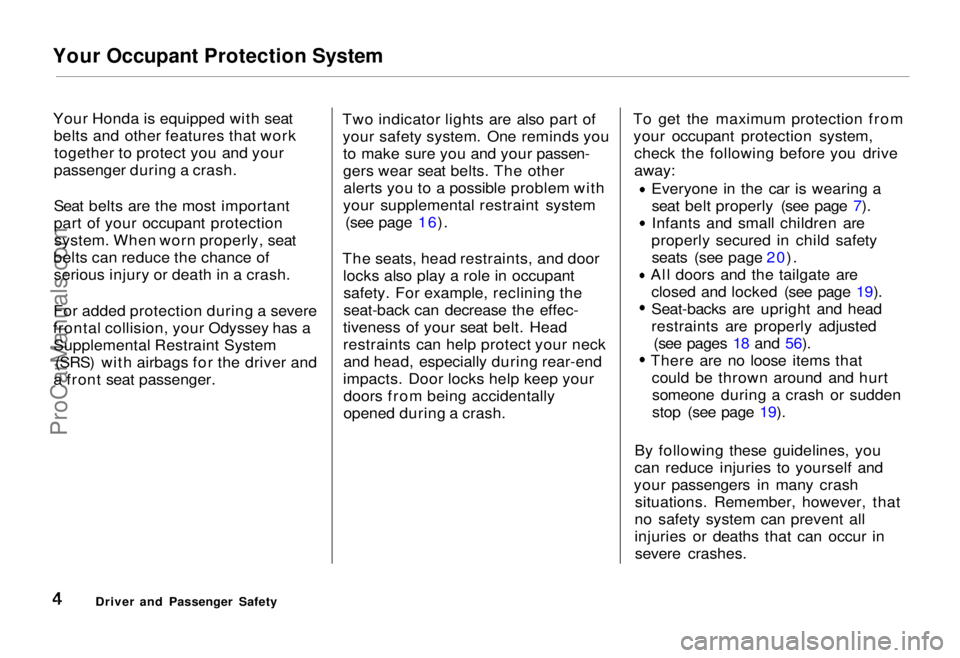
Your Occupant Protection System
Your Honda is equipped with seat belts and other features that worktogether to protect you and your
passenger during a crash.
Seat belts are the most important
part of your occupant protection system. When worn properly, seat
belts can reduce the chance of serious injury or death in a crash.
For added protection during a severe
frontal collision, your Odyssey has a Supplemental Restraint System (SRS) with airbags for the driver and
a front seat passenger. Two indicator lights are also part of
your safety system. One reminds youto make sure you and your passen-
gers wear seat belts. The otheralerts you to a possible problem with
your supplemental restraint system (see page 16).
The seats, head restraints, and door locks also play a role in occupantsafety. For example, reclining the
seat-back can decrease the effec-
tiveness of your seat belt. Head
restraints can help protect your neck and head, especially during rear-end
impacts. Door locks help keep your doors from being accidentally
opened during a crash. To get the maximum protection from
your occupant protection system, check the following before you drive
away:
Everyone in the car is wearing aseat belt properly (see page 7). Infants and small children are
properly secured in child safety seats (see page 20). All doors and the tailgate are
closed and locked (see page 19). Seat-backs are upright and head
restraints are properly adjusted
(see pages 18 and 56).
There are no loose items that could be thrown around and hurtsomeone during a crash or sudden
stop (see page 19).
By following these guidelines, you
can reduce injuries to yourself and
your passengers in many crash situations. Remember, however, that
no safety system can prevent all
injuries or deaths that can occur in severe crashes.
Driver and Passenger SafetyProCarManuals.comMain Menu Table of Contents s t
Page 19 of 240
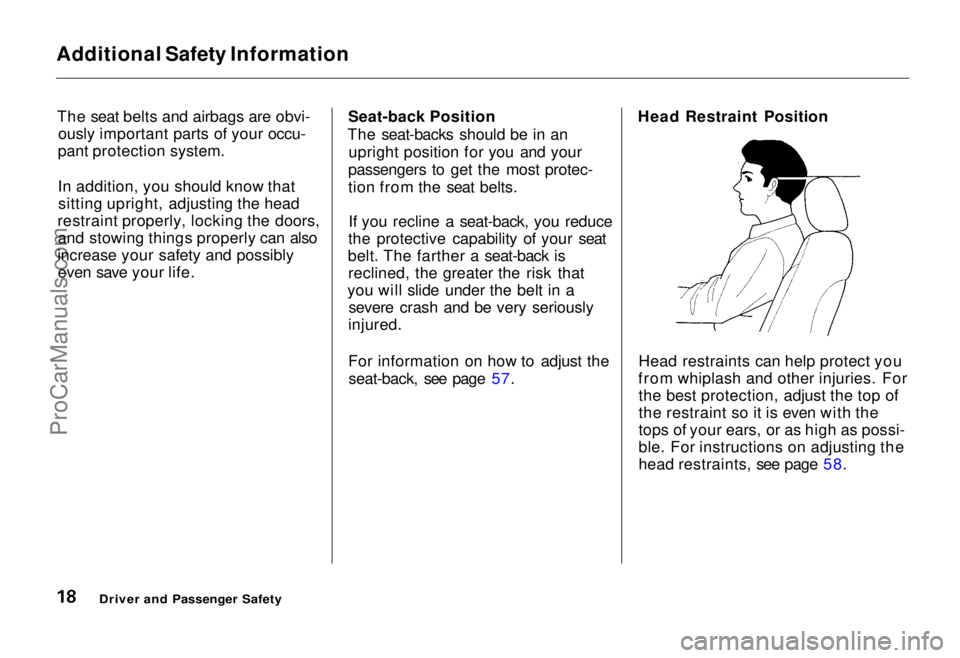
Additional Safety Information
The seat belts and airbags are obvi- ously important parts of your occu-
pant protection system.
In addition, you should know that sitting upright, adjusting the head
restraint properly, locking the doors, and stowing things properly can also
increase your safety and possibly even save your life. Seat-back Position
The seat-backs should be in an upright position for you and your
passengers to get the most protec-
tion from the seat belts.
If you recline a seat-back, you reduce
the protective capability of your seat
belt. The farther a seat-back is reclined, the greater the risk that
you will slide under the belt in a severe crash and be very seriously
injured.
For information on how to adjust the
seat-back, see page 57. Head Restraint Position
Head restraints can help protect you
from whiplash and other injuries. For the best protection, adjust the top of
the restraint so it is even with the
tops of your ears, or as high as possi-
ble. For instructions on adjusting the
head restraints, see page 58.
Driver and Passenger SafetyProCarManuals.comMain Menu Table of Contents s t
Page 20 of 240
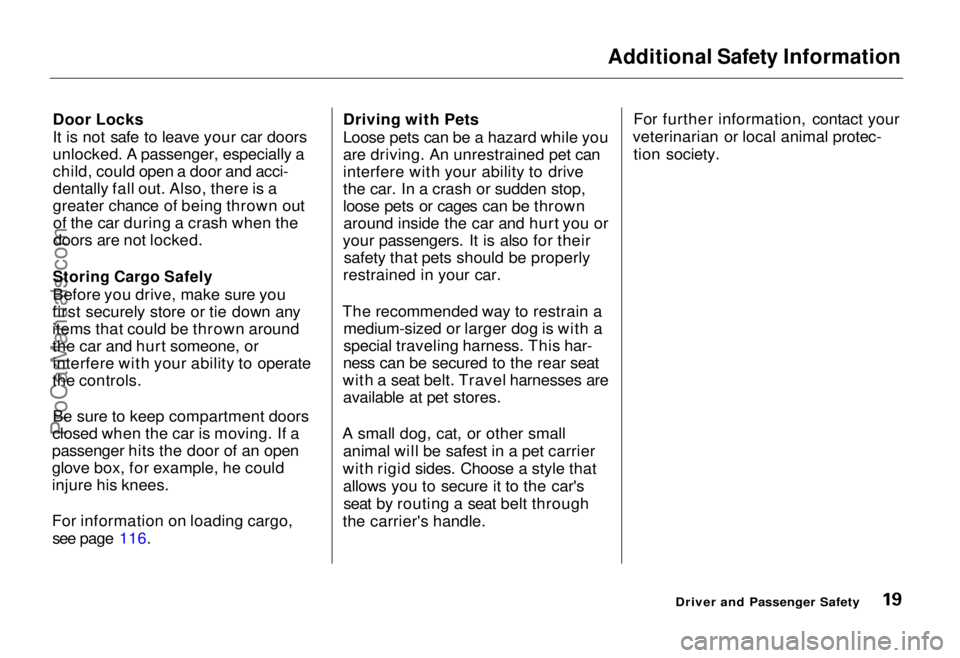
Additional Safety Information
Door Locks
It is not safe to leave your car doors
unlocked. A passenger, especially a
child, could open a door and acci- dentally fall out. Also, there is a
greater chance of being thrown out of the car during a crash when the
doors are not locked.
Storing Cargo Safely
Before you drive, make sure you
first securely store or tie down any
items that could be thrown around
the car and hurt someone, or interfere with your ability to operate
the controls.
Be sure to keep compartment doors
closed when the car is moving. If a
passenger hits the door of an open
glove box, for example, he could
injure his knees.
For information on loading cargo,
see page 116. Driving with Pets
Loose pets can be a hazard while you
are driving. An unrestrained pet can
interfere with your ability to drive
the car. In a crash or sudden stop,
loose pets or cages can be thrown
around inside the car and hurt you or
your passengers. It is also for their safety that pets should be properly
restrained in your car.
The recommended way to restrain a medium-sized or larger dog is with a
special traveling harness. This har-
ness can be secured to the rear seat
with a seat belt. Travel harnesses are available at pet stores.
A small dog, cat, or other small animal will be safest in a pet carrier
with rigid sides. Choose a style that allows you to secure it to the car'sseat by routing a seat belt through
the carrier's handle. For further information, contact your
veterinarian or local animal protec- tion society.
Driver and Passenger SafetyProCarManuals.comMain Menu Table of Contents s t
Page 22 of 240
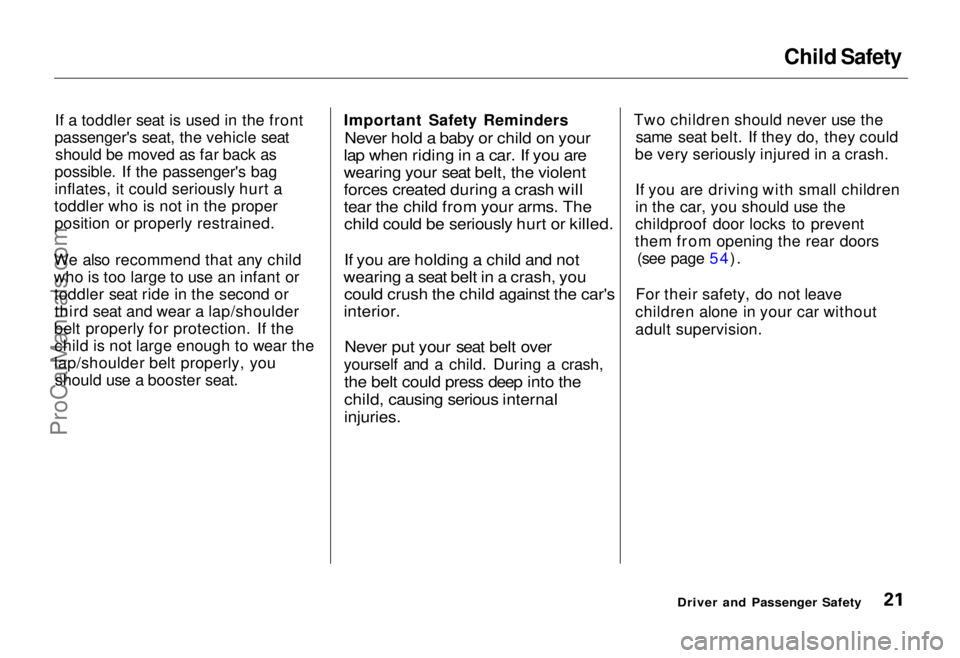
Child Safety
If a toddler seat is used in the front
passenger's seat, the vehicle seat should be moved as far back as
possible. If the passenger's bag
inflates, it could seriously hurt a
toddler who is not in the proper position or properly restrained.
We also recommend that any child
who is too large to use an infant or toddler seat ride in the second orthird seat and wear a lap/shoulder
belt properly for protection. If the child is not large enough to wear the
lap/shoulder belt properly, you should use a booster seat. Important Safety Reminders
Never hold a baby or child on your
lap when riding in a car. If you are
wearing your seat belt, the violent
forces created during a crash will
tear the child from your arms. The child could be seriously hurt or killed.
If you are holding a child and not
wearing a seat belt in a crash, you could crush the child against the car's
interior.
Never put your seat belt over
yourself and a child. During a crash,
the belt could press deep into the
child, causing serious internal
injuries.
Two children should never use the
same seat belt. If they do, they could
be very seriously injured in a crash.
If you are driving with small children
in the car, you should use the
childproof door locks to prevent
them from opening the rear doors (see page 54).
For their safety, do not leave
children alone in your car without
adult supervision.
Driver and Passenger SafetyProCarManuals.comMain Menu Table of Contents s t
Page 26 of 240
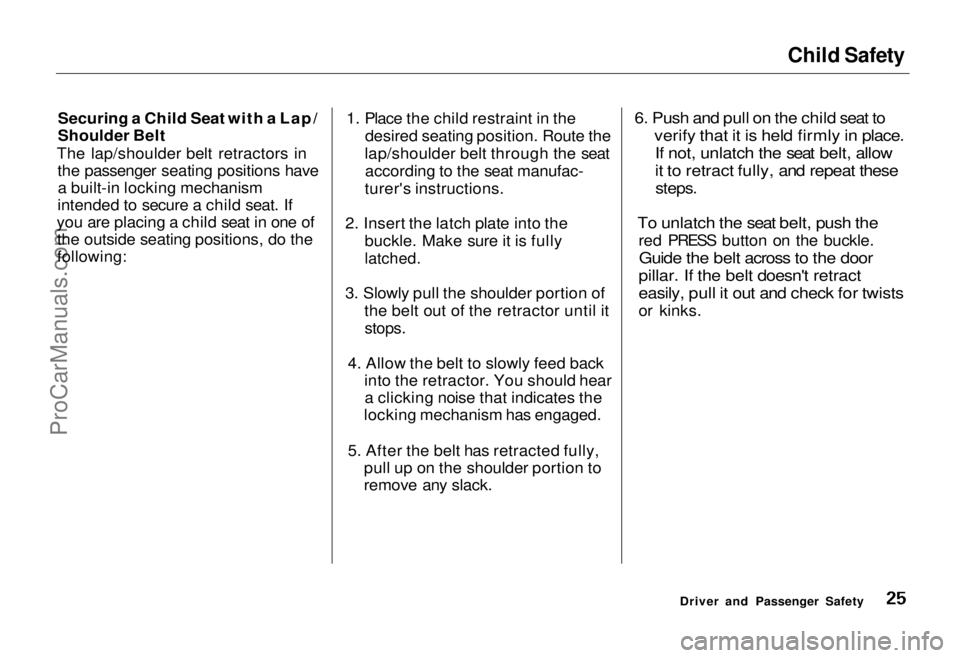
Child Safety
Securing a Child Seat with a Lap/
Shoulder Belt
The lap/shoulder belt retractors in the passenger seating positions havea built-in locking mechanism
intended to secure a child seat. If
you are placing a child seat in one of the outside seating positions, do the
following: 1. Place the child restraint in the
desired seating position. Route the
lap/shoulder belt through the seat according to the seat manufac-
turer's instructions.
2. Insert the latch plate into the buckle. Make sure it is fully
latched.
3. Slowly pull the shoulder portion of the belt out of the retractor until it
stops.
4. Allow the belt to slowly feed back into the retractor. You should heara clicking noise that indicates the
locking mechanism has engaged.
5. After the belt has retracted fully, pull up on the shoulder portion to
remove any slack.
6. Push and pull on the child seat to
verify that it is held firmly in place.
If not, unlatch the seat belt, allow
it to retract fully, and repeat these
steps.
To unlatch the seat belt, push the
red PRESS button on the buckle.
Guide the belt across to the door
pillar. If the belt doesn't retract
easily, pull it out and check for twists
or kinks.
Driver and Passenger SafetyProCarManuals.comMain Menu Table of Contents s t
Page 33 of 240
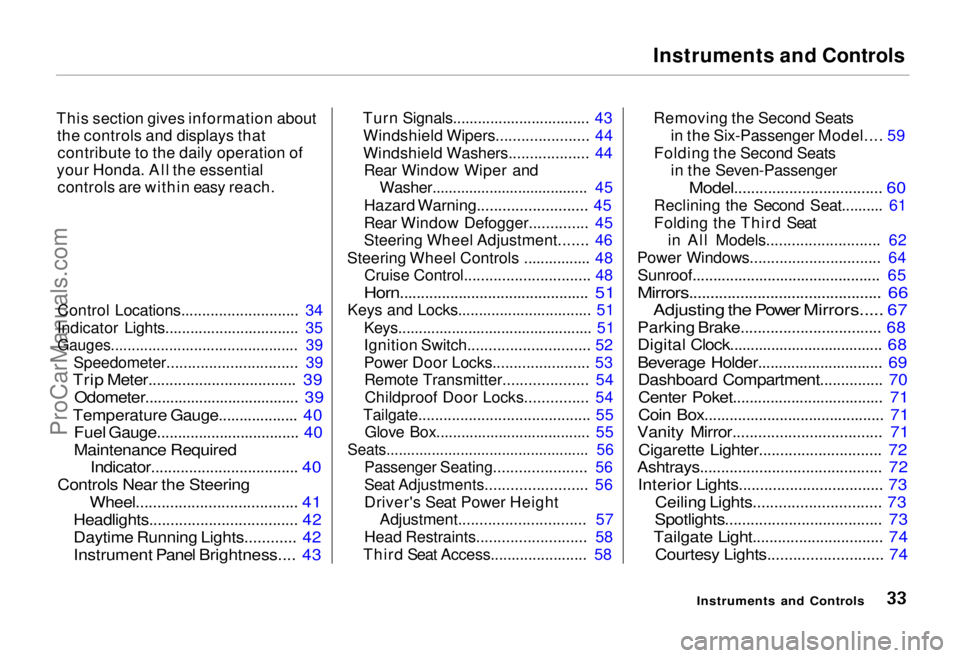
Instruments and Controls
This section gives information about the controls and displays thatcontribute to the daily operation of
your Honda. All the essential controls are within easy reach.
Control Locations............................ 34
Indicator Lights................................ 35
Gauges............................................. 39
Speedometer............................... 39
Trip Meter................................... 39
Odometer..................................... 39
Temperature Gauge................... 40
Fuel Gauge.................................. 40
Maintenance Required
Indicator................................... 40
Controls Near the Steering Wheel...................................... 41
Headlights...................................
42
Daytime Running
Lights............ 42
Instrument Panel Brightness.... 43
Turn Signals................................. 43
Windshield Wipers...................... 44
Windshield Washers................... 44 Rear Window Wiper and Washer...................................... 45
Hazard Warning.......................... 45
Rear Window Defogger.............. 45
Steering Wheel Adjustment....... 46
Steering Wheel Controls ................ 48 Cruise Control.............................. 48
Horn............................................. 51
Keys and Locks................................ 51
Keys............................................... 51
Ignition Switch............................. 52
Power Door Locks....................... 53Remote Transmitter.................... 54
Childproof Door Locks............... 54
Tailgate......................................... 55 Glove Box..................................... 55
Seats................................................. 56
Passenger Seating...................... 56
Seat Adjustments........................ 56
Driver's Seat Power HeightAdjustment.............................. 57
Head Restraints.......................... 58
Third Seat Access....................... 58 Removing the Second Seats
in the Six-Passenger Model.... 59
Folding the Second Seats in the Seven-Passenger
Model................................... 60
Reclining the Second Seat.......... 61
Folding the Third Seat in All Models...........................
62
Power Windows.............................. .
64
Sunroof............................................. 65
Mirrors............................................. 66
Adjusting the Power Mirrors.....
67
Parking Brake.................................
68
Digital Clock..................................... 68
Beverage Holder.............................. 69 Dashboard Compartment............... 70
Center Poket.................................... 71
Coin Box........................................... 71
Vanity Mirror................................... 71
Cigarette Lighter............................. 72
Ashtrays........................................... 72
Interior Lights.................................. 73
Ceiling Lights.............................. 73
Spotlights..................................... 73
Tailgate Light............................... 74 Courtesy Lights........................... 74
Instruments and ControlsProCarManuals.comMain Menu s t
Page 34 of 240
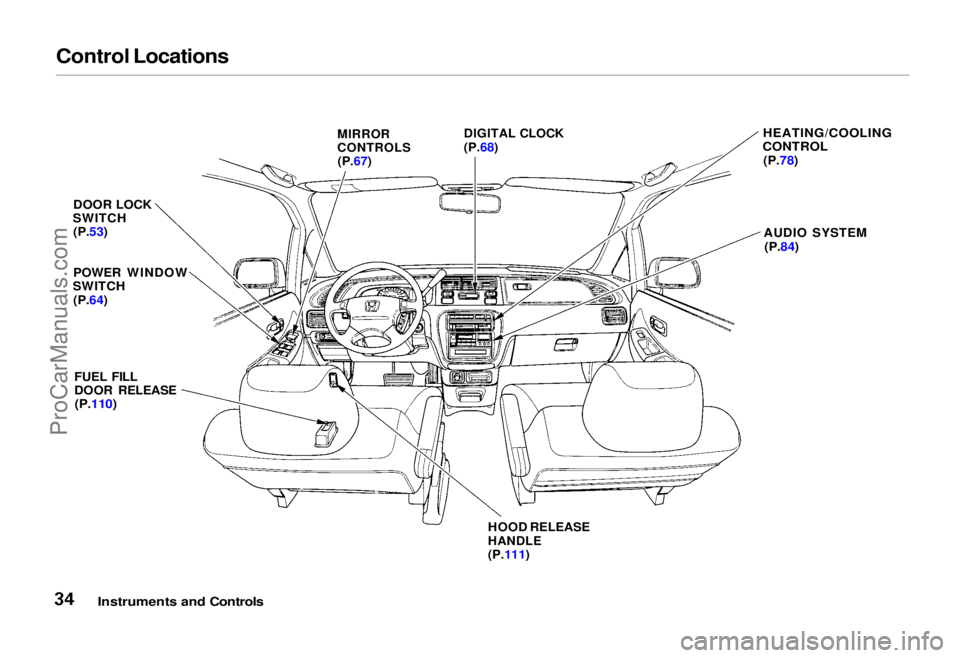
Control Locations
DOOR LOCK
SWITCH
(P.53)
POWER WINDOW
SWITCH
(P.64)
FUEL FILL
DOOR RELEASE
(P.110)
HOOD RELEASE
HANDLE
(P.111)
HEATING/COOLING
CONTROL
(P.78)
AUDIO SYSTEM
(P.84)
Instruments and Controls
MIRROR
CONTROLS
(P.67)
DIGITAL CLOCK
(P.68)ProCarManuals.comMain Menu Table of Contents s t